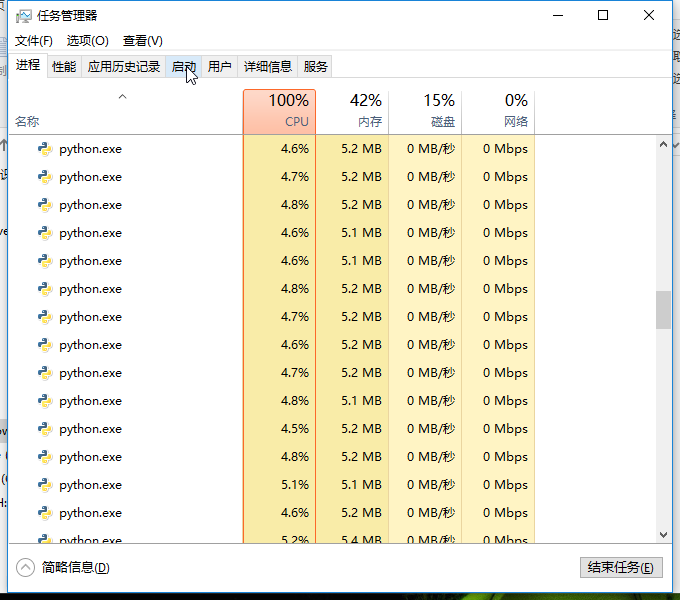对比实验
资料显示,如果多线程的进程是CPU密集型的,那多线程并不能有多少效率上的提升,相反还可能会因为线程的频繁切换,导致效率下降,推荐使用多进程;如果是IO密集型,多线程进程可以利用IO阻塞等待时的空闲时间执行其他线程,提升效率。所以我们根据实验对比不同场景的效率
| 操作系统 | CPU | 内存 | 硬盘 |
|---|---|---|---|
| Windows 10 | 双核 | 8GB | 机械硬盘 |
(1)引入所需要的模块
import requests import time from threading import Thread from multiprocessing import Process
(2)定义CPU密集的计算函数
def count(x, y):
# 使程序完成50万计算
c = 0
while c < 500000:
c += 1
x += x
y += y
(3)定义IO密集的文件读写函数
def write():
f = open("test.txt", "w")
for x in range(5000000):
f.write("testwrite\n")
f.close()
def read():
f = open("test.txt", "r")
lines = f.readlines()
f.close()
(4) 定义网络请求函数
_head = {
'User-Agent': 'Mozilla/5.0 (Windows NT 10.0; WOW64) AppleWebKit/537.36 (KHTML, like Gecko) Chrome/48.0.2564.116 Safari/537.36'}
url = "http://www.tieba.com"
def http_request():
try:
webPage = requests.get(url, headers=_head)
html = webPage.text
return {"context": html}
except Exception as e:
return {"error": e}
(5)测试线性执行IO密集操作、CPU密集操作所需时间、网络请求密集型操作所需时间
# CPU密集操作
t = time.time()
for x in range(10):
count(1, 1)
print("Line cpu", time.time() - t)
# IO密集操作
t = time.time()
for x in range(10):
write()
read()
print("Line IO", time.time() - t)
# 网络请求密集型操作
t = time.time()
for x in range(10):
http_request()
print("Line Http Request", time.time() - t)
(6)测试多线程并发执行CPU密集操作所需时间
counts = []
t = time.time()
for x in range(10):
thread = Thread(target=count, args=(1,1))
counts.append(thread)
thread.start()
e = counts.__len__()
while True:
for th in counts:
if not th.is_alive():
e -= 1
if e <= 0:
break
print(time.time() - t)
(7)测试多线程并发执行IO密集操作所需时间
def io():
write()
read()
t = time.time()
ios = []
t = time.time()
for x in range(10):
thread = Thread(target=count, args=(1,1))
ios.append(thread)
thread.start()
e = ios.__len__()
while True:
for th in ios:
if not th.is_alive():
e -= 1
if e <= 0:
break
print(time.time() - t)
(8)测试多线程并发执行网络密集操作所需时间
t = time.time()
ios = []
t = time.time()
for x in range(10):
thread = Thread(target=http_request)
ios.append(thread)
thread.start()
e = ios.__len__()
while True:
for th in ios:
if not th.is_alive():
e -= 1
if e <= 0:
break
print("Thread Http Request", time.time() - t)
(9)测试多进程并发执行CPU密集操作所需时间
counts = []
t = time.time()
for x in range(10):
process = Process(target=count, args=(1,1))
counts.append(process)
process.start()
e = counts.__len__()
while True:
for th in counts:
if not th.is_alive():
e -= 1
if e <= 0:
break
print("Multiprocess cpu", time.time() - t)
(10)测试多进程并发执行IO密集型操作
t = time.time()
ios = []
t = time.time()
for x in range(10):
process = Process(target=io)
ios.append(process)
process.start()
e = ios.__len__()
while True:
for th in ios:
if not th.is_alive():
e -= 1
if e <= 0:
break
print("Multiprocess IO", time.time() - t)
(11)测试多进程并发执行Http请求密集型操作
t = time.time()
httprs = []
t = time.time()
for x in range(10):
process = Process(target=http_request)
ios.append(process)
process.start()
e = httprs.__len__()
while True:
for th in httprs:
if not th.is_alive():
e -= 1
if e <= 0:
break
print("Multiprocess Http Request", time.time() - t)
实验结果
| CPU密集型操作 | IO密集型操作 | 网络请求密集型操作 | |
|---|---|---|---|
| 线性操作 | 94.91824996469 | 22.46199995279 | 7.3296000004 |
| 多线程操作 | 101.1700000762 | 24.8605000973 | 0.5053332647 |
| 多进程操作 | 53.8899999857 | 12.7840000391 | 0.5045000315 |
通过上面的结果,我们可以看到:
多线程在IO密集型的操作下似乎也没有很大的优势(也许IO操作的任务再繁重一些就能体现出优势),在CPU密集型的操作下明显地比单线程线性执行性能更差,但是对于网络请求这种忙等阻塞线程的操作,多线程的优势便非常显著了
多进程无论是在CPU密集型还是IO密集型以及网络请求密集型(经常发生线程阻塞的操作)中,都能体现出性能的优势。不过在类似网络请求密集型的操作上,与多线程相差无几,但却更占用CPU等资源,所以对于这种情况下,我们可以选择多线程来执行






